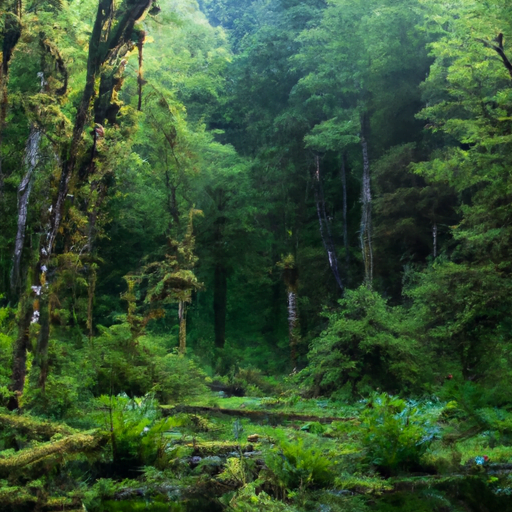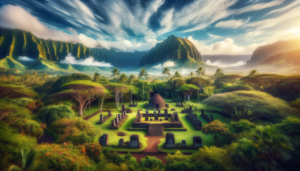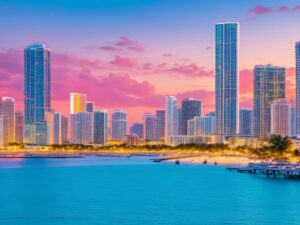Get ready to be amazed as you embark on an unforgettable journey into the heart of Alaskan coastal rainforests. Step into a world of unexpected lushness that will leave you breathless. From towering ancient trees to vibrant wildlife, these enchanting rainforests are a hidden gem just waiting to be discovered. Lose yourself in the rhythmic sounds of nature, soak in the serenity of moss-covered landscapes, and witness the spectacular beauty that lies within this ecological treasure trove. So pack your bags, grab your camera, and let Alaska’s coastal temperate rainforests take your breath away.
Table of Contents
ToggleIntroduction to Alaskan Coastal Rainforests
Definition of a coastal temperate rainforest
Alaska’s coastal temperate rainforests are unique ecosystems characterized by their abundant rainfall, moderate temperatures, and dense vegetation. These rainforests are found along the southeastern coast of Alaska, stretching from the panhandle down to the southern tip of the state. Unlike the typical image of a rainforest with towering canopies and dense undergrowth, Alaska’s rainforests have a more temperate climate and consist of a mix of coniferous and deciduous trees.
Location and climate of Alaska’s coastal temperate rainforests
Alaska’s coastal temperate rainforests are primarily located in the unpredictable weather conditions of the Pacific Northwest. These rainforests extend for approximately 600 miles from the southern panhandle region near Ketchikan to central Prince William Sound. They thrive in a region where the Pacific Ocean interacts with the rugged coastal mountains, creating a unique climate known for its mild, wet winters and cooler, drier summers. The abundant rainfall, ranging from 60 to 200 inches annually, sustains the lush vegetation that characterizes these rainforests.
Flora and Fauna of Alaska’s Coastal Temperate Rainforests
Diversity and abundance of plant life
Alaska’s coastal temperate rainforests boast an impressive array of plant species, making them some of the most biodiverse areas in North America. The forests are dominated by towering conifer trees such as Sitka spruce, western red cedar, and western hemlock. These trees can reach astonishing heights, with some individuals towering over 200 feet and living for over 500 years. The understory is filled with a rich variety of mosses, ferns, and wildflowers, creating a vibrant and diverse ecosystem.
Endangered and unique plant species
Within these rainforests, there are several plant species that are considered endangered or unique to the region. One such species is the yellow cedar, which is prized for its fine-grained wood but has been declining due to climate change impacts. The Prince of Wales Island golden spruce is another remarkable species found only in a small pocket of rainforest on Prince of Wales Island. Its distinct golden color and rarity make it a true treasure of Alaska’s rainforests.
Animal species found in the rainforest
Alaska’s coastal temperate rainforests also provide a haven for a diverse range of animal species. Grizzly bears, black bears, and wolves roam the forest floor, while bald eagles and marbled murrelets soar above the towering trees. The rivers and streams that flow through these rainforests are home to several species of salmon, such as chinook, coho, and pink salmon, which play a vital role in the ecosystem as they return from the ocean to spawn. Otters, seals, and sea lions can also be spotted along the coast, adding to the rich biodiversity of the region.
Importance of Alaska’s Coastal Temperate Rainforests
Biodiversity and ecological significance
The coastal temperate rainforests of Alaska are of immense ecological significance due to their rich biodiversity. They provide habitat for numerous plant and animal species, many of which are unique and endemic to the region. The interconnected web of life within these rainforests is crucial for maintaining the overall health and resilience of the ecosystem. The diverse array of species, from the towering trees to the smallest mosses, form a complex tapestry that contributes to the overall balance and functioning of the rainforest ecosystem.
Role in carbon sequestration and climate regulation
Alaska’s coastal temperate rainforests also play a crucial role in mitigating climate change. The massive trees and dense vegetation act as carbon sinks, absorbing and storing vast amounts of carbon dioxide from the atmosphere. This helps to reduce greenhouse gas emissions and mitigate the effects of climate change. Additionally, the rainforests regulate regional climate patterns by influencing local temperatures and humidity levels. Their proximity to the ocean and their ability to retain moisture contribute to the unique climatic conditions of the region.
Cultural significance to indigenous communities
The coastal temperate rainforests hold deep cultural significance to the indigenous communities that have inhabited the region for thousands of years. These forests have provided sustenance, shelter, and spiritual connection for Native Alaskan tribes such as the Tlingit, Haida, and Tsimshian. They are the source of traditional medicines, materials for crafts, and stories that form an integral part of their cultural heritage. Protecting and preserving these rainforests is not only important for biodiversity conservation but also for maintaining the cultural traditions and identity of indigenous communities.
Threats to Alaska’s Coastal Temperate Rainforests
Logging and deforestation
One of the major threats facing Alaska’s coastal temperate rainforests is logging and deforestation. Historically, the old-growth trees of these rainforests have been targeted for timber extraction, leading to significant habitat loss and degradation. Clear-cut logging practices have caused irreparable damage to the ecosystem, disrupting the delicate balance of the forest and displacing countless plant and animal species. Although sustainable logging practices have been implemented in recent years, the ongoing demand for timber continues to pose a threat to the rainforests.
Climate change and its impacts
Climate change is another significant threat to Alaska’s coastal temperate rainforests. Rising temperatures, changing precipitation patterns, and increased frequency of extreme weather events pose a risk to the delicate balance of these ecosystems. The warming climate has already led to the decline of certain plant species, such as the yellow cedar mentioned earlier. Melting glaciers and reduced snowpack also impact the availability of freshwater resources, which can have cascading effects on the entire ecosystem. It is essential to mitigate the impacts of climate change to ensure the long-term survival of these rainforests.
Invasive species and their effects
Invasive species pose a lesser-known but equally harmful threat to Alaska’s coastal temperate rainforests. Non-native plant species, such as Japanese knotweed and purple loosestrife, can quickly outcompete and displace native vegetation, disrupting the balance of the ecosystem. Invasive animal species, such as the European green crab and the bullfrog, can wreak havoc on local populations and biodiversity. Efforts to monitor and control the spread of invasive species are crucial to preserving the integrity and biodiversity of the rainforests.
Conservation Efforts for Alaska’s Coastal Temperate Rainforests
Protected areas and national parks
To safeguard the coastal temperate rainforests, several protected areas and national parks have been established. Glacier Bay National Park and Preserve, Tongass National Forest, and Misty Fjords National Monument are just a few of the designated conservation areas. These protected areas provide a safe haven for the diverse flora and fauna found in the rainforests and allow for the sustainable use of resources. Strict regulations and management plans aim to balance conservation efforts with responsible human activities within these protected areas.
Policy and legislation for sustainable management
In addition to protected areas, policy and legislation play a crucial role in the sustainable management of Alaska’s coastal temperate rainforests. The Tongass National Forest, for example, has a Forest Plan that guides decision-making to ensure ecological integrity while allowing for responsible resource extraction. Federal laws, such as the Alaska National Interest Lands Conservation Act and the National Forest Management Act, provide a framework for managing public lands in a sustainable and inclusive manner. Stakeholder involvement and public input are encouraged to shape these policies and ensure the long-term preservation of the rainforests.
Collaborative efforts by stakeholders
Conservation efforts for Alaska’s coastal temperate rainforests also involve collaboration among various stakeholders. Indigenous communities, environmental organizations, government agencies, and scientific experts work together to develop and implement strategies for conservation and sustainable management. Collaborative initiatives, such as research projects, community-based conservation programs, and partnerships with local businesses, aim to protect the rainforests while supporting the well-being and livelihoods of the local communities. By working together, these stakeholders can maximize the effectiveness of their conservation efforts and achieve long-lasting results.
Exploring the Rainforests: Popular Activities
Hiking and backpacking trails
Alaska’s coastal temperate rainforests offer an abundance of hiking and backpacking trails for visitors to explore. These trails wind through ancient forests, offering glimpses of towering trees, lush undergrowth, and stunning vistas. Popular trails include the West Glacier Trail in Juneau and the Deer Mountain Trail in Ketchikan. Whether you are an experienced hiker or a casual nature enthusiast, there are trails of varying levels of difficulty that cater to all skill levels.
Wildlife viewing and photography
For wildlife enthusiasts and photographers, Alaska’s coastal temperate rainforests provide unparalleled opportunities to observe and capture the region’s diverse fauna. From bears fishing for salmon to eagles soaring overhead, the rainforests are teeming with wildlife. Guided tours and wildlife viewing platforms offer a safe and educational way to get up close to these remarkable creatures. Remember to bring your camera and capture the magical moments that unfold in this natural paradise.
Canoeing and kayaking adventures
The waterways and fjords that embrace Alaska’s coastal temperate rainforests also present fantastic opportunities for canoeing and kayaking adventures. Paddling through the calm waters, surrounded by towering trees and rugged cliffs, provides a unique perspective on the beauty of the rainforests. Whether you choose to explore Misty Fjords National Monument, Glacier Bay, or Tongass National Forest, a paddling excursion allows you to immerse yourself in the serene and awe-inspiring landscapes of the rainforests.
Unique Features of Alaska’s Coastal Temperate Rainforests
Giant old-growth trees and their significance
One of the most striking features of Alaska’s coastal temperate rainforests is the presence of giant old-growth trees. These ancient trees, some of which are over 1,000 years old, stand as silent witnesses to the centuries that have passed. Their towering presence not only contributes to the remarkable beauty of the rainforests but also plays a crucial role in the ecosystem. These old-growth trees provide nesting sites for birds, habitat for countless organisms, and contribute to the overall stability of the forest ecosystem.
Misty fjords and breathtaking landscapes
The misty fjords that carve their way through the coastline add an ethereal touch to the landscapes of Alaska’s coastal temperate rainforests. These deep, narrow inlets are flanked by steep cliffs, cascading waterfalls, and dense forest cover. Navigating through these fjords, you are immersed in a world of mist-shrouded mountains and hidden wonders, creating a sense of awe and wonder. The interplay of light, mist, and lush vegetation makes these fjords a photographer’s dream and a sightseer’s paradise.
Glacial activity and its influence on the rainforests
Glacial activity has significantly shaped Alaska’s coastal temperate rainforests. As glaciers advance and retreat, they leave their mark on the landscape, creating valleys, fjords, and deep lakes. Melting glacial ice also feeds the rivers and streams that flow through the rainforests, providing a constant source of freshwater that supports the ecosystem. The presence of glaciers adds a sense of grandeur and timelessness to these rainforests, reminding us of the dynamic forces that have shaped this extraordinary environment.
Guided Tours and Sustainable Tourism in the Rainforests
Local tour operators and eco-friendly practices
To explore Alaska’s coastal temperate rainforests responsibly, it is recommended to choose guided tours operated by local companies that prioritize sustainable practices. These tour operators have a deep understanding of the rainforests and the importance of minimizing their ecological footprint. They strive to educate visitors about the fragile nature of the ecosystem and promote responsible behavior. Some tour operators may even contribute a percentage of their profits towards conservation efforts, ensuring that your visit contributes to the preservation of the rainforests.
Responsible visitor guidelines and nature conservation
When visiting the rainforests, it is essential to follow responsible visitor guidelines to minimize your impact on the environment. Stay on designated trails to avoid trampling delicate vegetation, and refrain from removing or disturbing any plants or wildlife. Take care not to leave any trash behind and respect the natural beauty of the rainforests. By adhering to these guidelines, you can help preserve the fragile balance of the ecosystem and ensure that future generations can also enjoy the wonders of Alaska’s coastal temperate rainforests.
Challenges and Future of Alaska’s Coastal Temperate Rainforests
Balancing conservation and economic development
One of the greatest challenges in the conservation of Alaska’s coastal temperate rainforests is finding a balance between preserving the ecosystem and promoting economic development. The extraction of natural resources, such as timber and minerals, has been a source of conflict, with concerns about the long-term sustainability of these practices. It is crucial to develop strategies that prioritize the well-being of the rainforests and the communities that rely on them, while also ensuring a sustainable economic future for the region.
Addressing climate change threats
As climate change continues to escalate, it is imperative to address the threats it poses to Alaska’s coastal temperate rainforests. Reducing greenhouse gas emissions, transitioning to renewable energy sources, and promoting sustainable land management practices are crucial steps in mitigating these threats. Additionally, monitoring and research efforts can help understand the specific impacts of climate change on the rainforests and inform adaptive management strategies to preserve their integrity and resilience.
Promoting sustainable tourism
Sustainable tourism practices play a vital role in the future of Alaska’s coastal temperate rainforests. By promoting sustainable tourism, such as using eco-friendly accommodations, supporting local businesses, and engaging in responsible outdoor activities, visitors can contribute to the conservation of these fragile ecosystems. By fostering an appreciation for the rainforests’ natural beauty and ecological importance, sustainable tourism initiatives can create economic incentives for conservation efforts and help ensure the long-term protection of these invaluable resources.
Conclusion
Alaska’s coastal temperate rainforests are captivating and awe-inspiring ecosystems that deserve our utmost respect and protection. With their rich biodiversity, vital role in carbon sequestration and climate regulation, and cultural significance to indigenous communities, these rainforests are truly remarkable. However, they face numerous challenges, including logging, climate change, and invasive species. Through collaborative conservation efforts, responsible tourism practices, and sustainable management strategies, we can work towards a future where these rainforests thrive for generations to come. Let us cherish and preserve the wonders of Alaska’s coastal temperate rainforests, ensuring their survival and the well-being of the diverse species that call them home.





